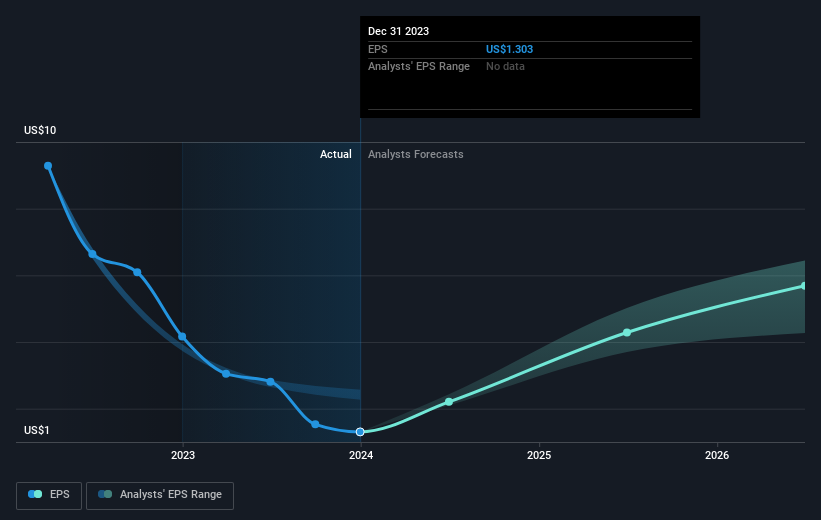Stock Analysis
- United States
- /
- Personal Products
- /
- NYSE:EL
Estée Lauder Companies' (NYSE:EL) earnings trajectory could turn positive as the stock ascends 4.0% this past week

The Estée Lauder Companies Inc. (NYSE:EL) shareholders should be happy to see the share price up 15% in the last quarter. Meanwhile over the last three years the stock has dropped hard. Tragically, the share price declined 54% in that time. So it's good to see it climbing back up. While many would remain nervous, there could be further gains if the business can put its best foot forward.
While the stock has risen 4.0% in the past week but long term shareholders are still in the red, let's see what the fundamentals can tell us.
View our latest analysis for Estée Lauder Companies
To paraphrase Benjamin Graham: Over the short term the market is a voting machine, but over the long term it's a weighing machine. One way to examine how market sentiment has changed over time is to look at the interaction between a company's share price and its earnings per share (EPS).
During the three years that the share price fell, Estée Lauder Companies' earnings per share (EPS) dropped by 20% each year. This fall in EPS isn't far from the rate of share price decline, which was 23% per year. So it seems like sentiment towards the stock hasn't changed all that much over time. Rather, the share price has approximately tracked EPS growth.
You can see how EPS has changed over time in the image below (click on the chart to see the exact values).

It's probably worth noting we've seen significant insider buying in the last quarter, which we consider a positive. On the other hand, we think the revenue and earnings trends are much more meaningful measures of the business. This free interactive report on Estée Lauder Companies' earnings, revenue and cash flow is a great place to start, if you want to investigate the stock further.
A Different Perspective
While the broader market gained around 21% in the last year, Estée Lauder Companies shareholders lost 43% (even including dividends). However, keep in mind that even the best stocks will sometimes underperform the market over a twelve month period. Unfortunately, last year's performance may indicate unresolved challenges, given that it was worse than the annualised loss of 2% over the last half decade. Generally speaking long term share price weakness can be a bad sign, though contrarian investors might want to research the stock in hope of a turnaround. It's always interesting to track share price performance over the longer term. But to understand Estée Lauder Companies better, we need to consider many other factors. Take risks, for example - Estée Lauder Companies has 4 warning signs (and 2 which are a bit concerning) we think you should know about.
If you like to buy stocks alongside management, then you might just love this free list of companies. (Hint: insiders have been buying them).
Please note, the market returns quoted in this article reflect the market weighted average returns of stocks that currently trade on American exchanges.
Valuation is complex, but we're helping make it simple.
Find out whether Estée Lauder Companies is potentially over or undervalued by checking out our comprehensive analysis, which includes fair value estimates, risks and warnings, dividends, insider transactions and financial health.
View the Free AnalysisHave feedback on this article? Concerned about the content? Get in touch with us directly. Alternatively, email editorial-team (at) simplywallst.com.
This article by Simply Wall St is general in nature. We provide commentary based on historical data and analyst forecasts only using an unbiased methodology and our articles are not intended to be financial advice. It does not constitute a recommendation to buy or sell any stock, and does not take account of your objectives, or your financial situation. We aim to bring you long-term focused analysis driven by fundamental data. Note that our analysis may not factor in the latest price-sensitive company announcements or qualitative material. Simply Wall St has no position in any stocks mentioned.
About NYSE:EL
Estée Lauder Companies
The Estée Lauder Companies Inc. manufactures, markets, and sells skin care, makeup, fragrance, and hair care products worldwide.
Reasonable growth potential with mediocre balance sheet.

